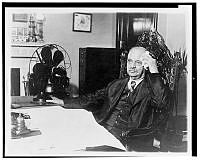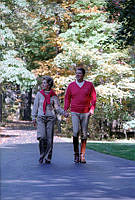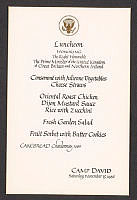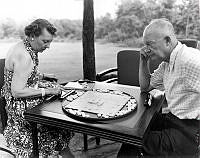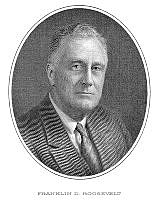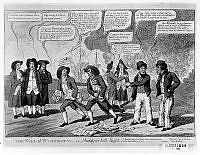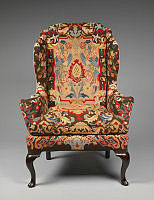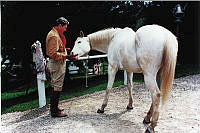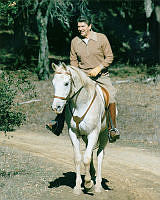Rubenstein Center Scholarship
Camp David
The White House in the Mountains of Maryland
Sixty miles outside of Washington, D.C. is a rustic wilderness retreat that serves presidents and first families as a secluded getaway from the White House. Camp David was originally built as a camp for federal employees and their families, a project completed in 1938 through the Works Progress Administration (WPA) during the New Deal. The camp is located east of Hagerstown and north of Frederick in the Catoctin Mountains of western Maryland, near the towns of Thurmont and Emmitsburg.
It might have remained a federal employee recreation spot if World War II had not intervened. President Franklin Roosevelt previously used the presidential yacht, the USS Potomac, for relaxation. However, after the United States entered the war, military and Secret Service officials became concerned about the president’s safety on the open waters of the Atlantic due to threats of German U-boats.1
Roosevelt requested that the National Park Service identify sites within one hundred miles of the White House that might serve as an alternative respite for the president. On April 22, 1942, FDR visited Camp Hi-Catoctin and selected it as the location for the future presidential retreat.2 It officially became a United States Naval installation, operated by military personnel. Roosevelt named it “Shangri-La” from the James Hilton novel, The Lost Horizon and began spending time there during the summer of 1942. Roosevelt had the main cabin renovated so that an extra-wide door was cut into the wall outside his bedroom, enabling a mechanical ramp for exiting in a wheelchair.3 The budget for the renovation and construction was $18,650.4 Security was maximized surrounding Shangri-La, with an alarmed fence and 100 Marines onsite when the president was in residence.5

This black and white photo is of President Franklin D. Roosevelt fishing in a stream, accompanied by British Prime Minister Winston Churchill. The presidential retreat during Roosevelt's administration was known as "Shangri-La" but was renamed by President Dwight D. Eisenhower after his grandson and is still known as "Camp David."
Franklin D. Roosevelt Presidential Library and Museum/NARAFDR began using the camp for two purposes: relaxation and international diplomacy. Roosevelt’s favorite spot at Shangri-La was the closed-in porch of his presidential cabin. He sat there to think, but also to enjoy an evening cocktail. With his own doghouse next to the presidential cabin, FDR’s dog Fala often joined him at the site.6 Roosevelt also decided that the campsite could host foreign leaders. Winston Churchill, the British prime minister, visited FDR at Shangri-La twice. During his 1943 stay, the two leaders discussed early planning for the 1944 D-Day invasion. Roosevelt also hosted Princess Martha of Norway and Princess Julianna of Netherlands at the camp. FDR made nineteen visits to Shangri-La and spent sixty-four days there during his presidency.7 The last recorded visit was on July 9, 1944, when FDR visited Shangri-La with his longtime paramour, Lucy Mercer Rutherford.8
Subsequent presidents made important additions to the presidential retreat. Harry Truman spent less time than FDR at Shangri-La during his presidency, but he did make it a permanent federal facility. Truman also added heat to the cabins, enabling winter use of Shangri-La.9 Dwight Eisenhower is responsible for the renaming of the facility. He thought that the name Shangri-La was “just a little fancy for a Kansas farm boy.” Eisenhower chose “Camp David” in honor of his grandson. Mrs. Eisenhower also named the presidential cabin “Aspen,” which remains its designation today.10 As the first president to use a helicopter for transportation in 1957, Eisenhower added a helicopter landing site to Camp David, which shortened the trip from the White House to only thirty minutes.11 Decades later, Richard Nixon built a heated swimming pool adjacent to the president’s cabin. Ronald Reagan drew up plans for a non-denominational chapel, which was opened during George H.W. Bush’s tenure and named Evergreen. The only wedding to take place at Camp David occurred on June 27, 1992 when President Bush’s daughter, Doro, married Bobby Koch at Evergreen Chapel. The reception was held on the lawn of Aspen.12

Dwight Eisenhower and Mamie Eisenhower play board games at Camp David in 1954.
Dwight D. Eisenhower Presidential LibraryIn addition to the presidential cabin, there are approximately a dozen guest cabins at Camp David. A main cabin, called Laurel Lodge, provides three conference rooms, a dining room, and a small presidential office. Most diplomatic meetings take place here. Several presidents used the Laurel Lodge presidential office and its nearby outdoor patio as a location to issue a weekly presidential radio address. Hickory Lodge houses indoor recreational activities as well as a grill, bar, and gift shop. Holly Cabin provides smaller meeting rooms and recreational space.13
Over the years, presidents followed in FDR’s footsteps and used Camp David as a place to host foreign leaders and heads of state. In 1959, President Eisenhower welcomed Soviet Premier Nikita Khrushchev at Camp David for two days, the first visit of a Soviet leader on United States soil. After the visit, in which the two leaders watched American westerns, visited the camp’s recreation center, and dined on steak, Khrushchev coined the term “the spirit of Camp David.”14 It came to refer to unofficial diplomatic cooperation short of an official, signed agreement. The détente, unfortunately, only lasted less than a year before an American U-2 spy plane was shot down over the Soviet Union.15

Anwar Sadat and Menachem Begin greet each other before initial talks at Camp David, along with Jimmy Carter and Rosalynn Carter on September 7, 1978.
Jimmy Carter Presidential Library and Museum/NARAPresident Jimmy Carter hosted perhaps the most famous diplomatic negotiations at Camp David in September 1978 when Egyptian President Anwar Sadat and Israeli Prime Minister Menachem Begin spent thirteen days at the retreat. After a series of trilateral and bilateral talks, the result was a “framework for peace” agreed upon by all parties involved.16 The setting significantly influenced the results of the discussions. Camp David shielded Sadat and Begin from outside influences, including press. It also afforded recreational opportunities. Sadat reportedly walked the trails every morning, and fifty-eight movies were watched during the almost two-week stay at the camp.17
President Reagan didn’t host many foreign visitors at Camp David, but he did welcome British Prime Minister Margaret Thatcher in 1984. In a private meeting with Reagan, Thatcher recounted the recent visit of up-and-coming Soviet leader Mikhail Gorbachev to London. Her observations would prove quite prescient; she called Gorbachev an “unusual Russian.”18 During the presidency of George W. Bush, Russian President Vladimir Putin visited the camp. Putin described Camp David in his public remarks as “tranquil.”19 President Barack Obama hosted the largest foreign contingent in American history at Camp David when he welcomed the G-8 Summit to the site in 2012.

Barack Obama and world leaders watch a soccer match during the G-8 summit at Camp David in 2012.
Official White House Photo by Pete SouzaPresidents have also used Camp David as a secluded setting for important, high-level discussions and decisions. After the failed Bay of Pigs operation in Cuba, President John Kennedy invited former President Dwight Eisenhower to Camp David in April 1961 for a private consultation. This was Eisenhower’s fiftieth and final trip to Camp David.20 While at Camp David, on April 29, 1973, President Richard Nixon asked for the resignations of two top aides, John Ehrlichman and H.R. Haldeman.21 The Watergate firings, which had an almost “Shakespearean quality” to them, took place adjacent to the tulip garden of Aspen Lodge.22 In the days immediately following the September 11, 2001 terrorist attacks, President George W. Bush hosted key members of his cabinet and national security team at Camp David to strategize. President Bush convened numerous meetings and discussions during his time there, engaged in private reflection away from the press corps, and attended Sunday church service at the Evergreen chapel.23
In addition to engaging in diplomacy and hosting key staff, presidents and first families spend time at Camp David to relax and enjoy numerous recreational activities. Hiking, horseback riding, jogging, tennis, basketball, horseshoes, skeet shooting, and mountain biking are popular options for fun. A movie theater, game room, pool table, bowling alley, fitness center, and library are available for indoor leisure time. The first family and visitors use a fleet of Camp David golf carts as the preferred method of transportation within the complex.24

George W. Bush enjoys Christmas at Camp David in 2003.
Official White House Photo by Eric DraperSince World War II, every president and first family has visited Camp David to escape the daily pressures of the White House. Ronald Reagan described the relief provided by the bucolic site:
As president, the days I hated most were those of nonstop meetings, one after another, with no time in between to collect my thoughts…the days I liked best were those Fridays when I could break away a little early, about three or three-thirty, and take off for Camp David.25
Each president has discovered reasons for appreciating Camp David as a private retreat. Perhaps former White House staffer Ken Khachigian captured it most succinctly when he stated, “It’s where a president can be a human being again.”26

President Ronald Reagan and First Lady Reagan issue a joint radio address on federal drug policy at Camp David in 1982.
Ronald Reagan Presidential Library and Museum/NARA




